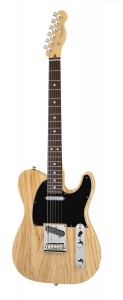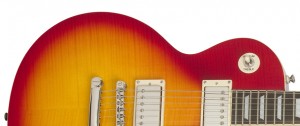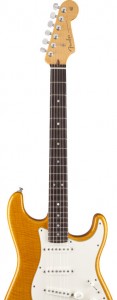The Anatomy of a Studio Guitar
Guitars, like people, come in all shapes, sizes and colors. Also much like people, when you look beneath the surface, they’re all made of the same stuff: In this case, wood, metal, plastic and curves.
For all the bewildering variation you may encounter in the wide world of guitars, there are but a manageable handful of variables that have a significant effect on tone. Because of this, getting deeply familiar with the basic anatomy of a guitar can simplify choices in the very best sense.
But getting to know what guitars are made of can have the opposite effect as well: You may some day find yourself playing two instruments that look similar but sound and feel like different beasts. Knowing what a guitar is made of can enhance your appreciation of the subtle differences that give each instrument its personality. In this way, a little knowledge around the anatomy of a guitar can also make the world of tone seem more complex, more interesting and engaging.
The Body: Wood Shapes Tone
Although it seems intuitive that wood could be a major factor in the sound of an acoustic instrument, people are often surprised to some to find out that the cut of wood that goes into an electric guitar can have a significant impact on its tone.
The strings of an electric don’t put out very much sound until you hook up to an amplifier, but even in the face of this limited acoustic power, the wood body of a guitar certainly shapes the way those strings vibrate. Different types of wood accentuate different frequencies and play a role in increasing either sustain or “snap.” These are differences that can be measured and heard blind. And most of it comes down to finding a workable balance between mass, density and rigidity.
The majority of high-quality Fender electrics are made from Alder, a popular North American tonewood. It’s lightweight, but also fairly stiff and rigid, with tight pores that run in long, slightly curving lines. Historically, it’s one of the most popular tonewoods for electrics with “bolt-on” necks, and its tone contributes the bright, tight sound of many Fender-style guitars.
But alder isn’t the only wood used for the body of these instruments. Only slightly more expensive are guitars made from the “Swamp Ash” of the eastern and central United States. These trees (not to be confused with the harder “northern” ash) grow well in humid regions and have developed a strong, rigid structure that’s interspersed with enormous, soft and open pores, arranged in a swirling grain pattern.
When compared to alder, guitars made from a good cut of “southern” ash might sound just a bit smoother and more open, with a bell-like top end, and supple lows. It’s a bit more “creamy” and resonant, but gone is a bit of alder’s authoritative bark and spunky bite, thanks to some subtle filtering of midrange frequencies.
Cheaper (and perhaps less visually appealing) than either of these is Basswood. Its extreme light weight, small pores and soft texture conspire to soften both the highest highs and the lowest lows, making it more midrangey and forward than alder, although with a slightly more subdued upper mids and top-end.
These woods may do just fine for Fender-style guitars with bolt-on necks, but “set-neck” electrics of the Gibson style are most often made out of a tonewood with some of the softest top-end around: Mahogany.
Mahogany is an open-pored wood, like swamp ash, but unlike swamp ash, its structure and density is fairly uniform. This leads to great sustain, slightly compressed mids and a dark upper-register, making it one of the thickest-sounding foundations available. It’s also beautiful looking wood in its own right, ranging in color from light mocha to deep chocolate when finished.
There are plenty of guitars that are made from solid mahogany and nothing but: Gibson SGs and the Les Paul Custom and “Studio” models (ironically not often the best pick as a default Les Paul to have in the studio) are particularly dark and throaty thanks in large part to their all-mahogany construction.
To compensate for this dark character, many Les Pauls, PRS guitars, and other luxury models add a thin piece of Hard Maple as a “cap”, which covers the entire face of the guitar.
Maple is not only an attractive wood (it often contains eye-catching natural “flame” patterns) but it can significantly alter the tone as well. Although this cap is rarely over 1/2” thick, it’s extremely hard and massive, adding plenty of sparkling highs and assertive upper midrange articulation to what might otherwise be a thick, almost murky-sounding instrument.
Makers of acoustic guitars often take a similar approach. Here, the most common wood for the face or “soundboard” is Spruce, which is stiff and bright. Meanwhile, the back and sides of an acoustic will often be made of mahogany, such as with the Gibson J45. Rosewood is another common choice for back and sides, and it’s found in acoustic guitars like the Martin D28 and D35. Although rosewood may be slightly more expensive, its added weight and rigidity provide tight, deep lows and a shimmering top end that can make a mahogany-backed acoustic sound dusty and homespun by comparison.
On classical guitars, rosewood is a common choice for the body, while the top is often made out of cedar, which which has some of the properties of spruce with a bit of a darker tone. You’ll occasionally find more exotic woods used in acoustics, such as Koa or Walnut, and now and then you may find an acoustic with tight, bright-sounding maple back sides – such as the Gibson J-200 or the Taylor 610.
Check Your Neck: Construction and Fingerboards
The wood of the body isn’t the only part that matters. Neck woods can have a significant impact as well. Fender-style guitars have a “bolt-on” neck, meaning it’s literally screwed onto the body. The neck itself is often made of maple, which is one of the strongest woods around, contributing to the tank-like resiliency of these guitars. It also contributes to the tone: The sheer mass and rigidity of maple, along with the bolt-on construction, limits sustain, adding to the percussive, snappy sound of this type of guitar.
To cap off the neck, you’ll find a fingerboard of either maple (which offers tremendous sparkling clarity and tight, lean bass) or rosewood (which provides darker top-end and more midrange in this context.) Occasionally, you’ll find Ebony — a rigid wood as black as its name. Itt offers some of the clarity and crystal highs of maple, but without as much loss of bass or fullness.
On Gibson-style electrics, the neck is almost always mahogany with either a rosewood or ebony fingerboard, and it’s almost always “set” into the body with a tight-fitting dovetail joint and glue. This combination leads to a darker, “warmer” tone, as well as increased sustain.
The only cost is durability: Knock a maple-necked guitar off a stand, and all you’ve got is an awful racket on your hands. Let a mahogany-necked SG to the floor from any height higher than your foot, and you’ll be on the line to the repair shop hoping someone can reattach your headstock for a reasonable fee.
Pickups: Turning Vibration Into Voltage
On an electric instrument, the pickup is the guitar’s window to the world. It’s the only other part of the instrument to have an impact on tone that will rival the effect of the wood it’s made from and the person playing it.
As most musicians already know, Fender-style guitars are often equipped with single-coil pickups, and Gibson-style guitars are more often found sporting dual-coil “humbuckers.”
By reversing the polarity of one magnet, the hum-bucking design reduces 60 cycle noise through phase cancellation. But it also has a dramatic impact on tone. Since the two magnets of a humbucker are wired “in series”, with the output of one magnet adding to the output of the other, humbuckers have far hotter output. But all things being equal, they’ll also have a significantly darker tone than a comparable single-coil. (It turns out that the clever phase cancellation trick of these pickups doesn’t just “buck” the hum, but also the highest frequencies.)
Single coils (which sound bright, glistening and bell-like in comparison to the smooth, crunchy or creamy response of the humbucker) are traditionally susceptible to plenty of noise when they’re played in isolation. But modern guitars offer some workarounds here: First, the “in-between” positions on a Stratocaster or Telecaster make use of 2 pickups. Since one magnet will be reverse polarity, this means that they have the same hum-rejecting benefit of a true humbucker. But, since they’re far apart and wired in parallel, splitting the output volume between the two pickups, they retain that single coil “quack” and “chime” while reducing noise. Some modern guitars come with hum-cancelling “stacked” single coils that operate on a similar premise.
Pickup positioning is also a big deal, as most guitarists already know. Part of what makes a telecaster bridge pickup sound so twangy is its placement – not just its design. Often enough, just switching pickups or strumming-hand position on a guitar is a far better call than swapping instruments or debating the finer points of pickup construction. But with that said, different pickup designs and materials can often significantly different tones.
In general, more “vintage” sounding guitars will have weaker magnets, while more modern-sounding instruments will have more powerful magnets. There’s a lot a designer can do with coil winding and magnetic field calibration to alter the tone of a pickup, but the raw materials are key as well.
Most classic pickups are made out of “Alnico,” a blend of aluminum, nickel and cobalt. (See what they did there?)
Alnico “2” is the weakest of these metal magnets, and very common in vintage-style designs. It offers a sweet, supple tone with a slightly compressed dynamic response that a lot of guitar players love. The next most common alloy is Alnico “5”, which is higher output and is often used in hotter, more modern designs.
On the far end of the spectrum, you have Ceramic Magnets which offer super-high output and a far brighter tone. These are most often used in humbucker designs, particularly when players want even more gain or a bit more articulation to combat the darkening effects of a humbucking design.
There’s more than enough to the world of guitar pickups to warrant a whole series of articles covering active vs. passive, series vs. parallel, over-winding vs. under-winding, and the special appeal of P-90 and “lipstick” pickups. But for now, you’re welcome to check out the websites of pickup manufacturers like Seymour Duncan and DiMarzio to read more and to hear some of these differences for yourself.
Accessories: More Impact Than You Might Think
So far, we’ve covered the body, head and voicebox of the guitar, and that’s what matters most aside from the person playing the thing. But there’s one more thing to mention: Engineers are often surprised to find that minute changes in guitar accessories can help make for a significant impact on tone.
Any engineer knows that when it comes to mic cables, balanced line cables, speaker cables and power cords, the impedances are too low and the voltages too high for high-end voodoo cables to make much of an appreciable difference in sound quality at all, particularly on normal-length runs. In the guitar world however, things are a little different. Thanks to the low voltage and high impedance of passive guitar pickups, slight variations in the capacitance or inductance of a cable can actually make a subtle difference, that can be measured, and in some cases, heard blind. This is not to say that all guitar cables will sound different from each other – but some can.
But far more important than this are some of the physical changes that go in the world of accessories: Changing your saddles or adding mass to the bridge? Yes, it actually can effect tone and sustain. Switching to new tuners or a low-friction nut? Yes, you can improve tuning stability. Switching picks or strumming position? Hells yes. In fact, understanding how these physical performance choices effect tone is perhaps more important than anything we’ve covered so far. Don’t just get to know your guitars. Get to know your guitar picks.
If you know how music is really made, then you know that in the end “the tone is in the fingers.” But that doesn’t mean nerding out about the tools now and then isn’t fun and worthwhile. If getting interested in these variables, even right up to the point of diminishing returns, keeps us interested and engaged then it’s well worth the effort. It’s only when you let an interest in tools supercede your interest in music that you’re really in trouble.
If you’re enough of a guitar nerd to have swallowed this article whole, then know this is just an introduction to a whole field of knowledge. Click on to read more about DIY setups, intonation and action adjustments. And if you ever find yourself getting too obsessed, remember that the perfect guitar is the one that you’re playing – regularly and well.
Justin Colletti is a Brooklyn-based audio engineer, college professor, and journalist. He records and mixes all over NYC, masters at JLM, teaches at CUNY, is a regular contributor to SonicScoop, and edits the music blog Trust Me, I’m A Scientist.
Please note: When you buy products through links on this page, we may earn an affiliate commission.











ashoke bhattacherjee
June 10, 2013 at 6:57 am (12 years ago)Nice post. Good balance of erudition & candor.
So we know that a $100 electric will be nothing like a good Fender or Gibson. But given the law of marginally diminishing returns, what is the perceptible difference of a exorbitant guitar?
Say we take a top of the line custom shop fender or gibson costing, say $3000-4000. Most will say that it has an excellent constructing with a perfect fret job. Now we take something like a Nick Huber costing, say $10,000. Both have the same shape and all the quality hardware is same including pickups and strings. What will be the differentiating factors? What will the construction reveal in a blind test?
How much will the tone differ? Both have good quality wood, but the boutique one has some rare or exotic wood. The tone will be different, but will it be perceptive to a discerning ear as something tangibly better?
thanks
Mason Austin Green
December 18, 2014 at 1:53 pm (10 years ago)Interesting article; too bad tone wood is a myth.
Justin C.
June 25, 2016 at 6:44 pm (9 years ago)Evidence please?